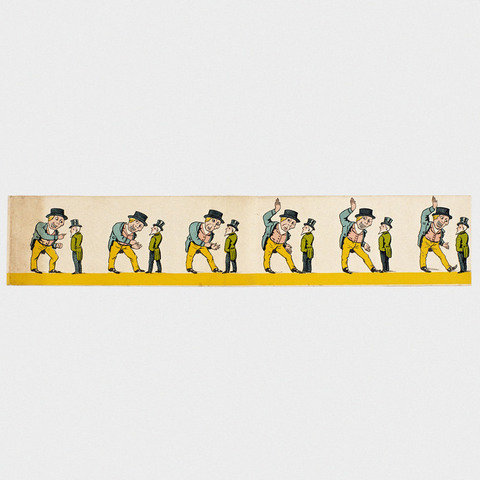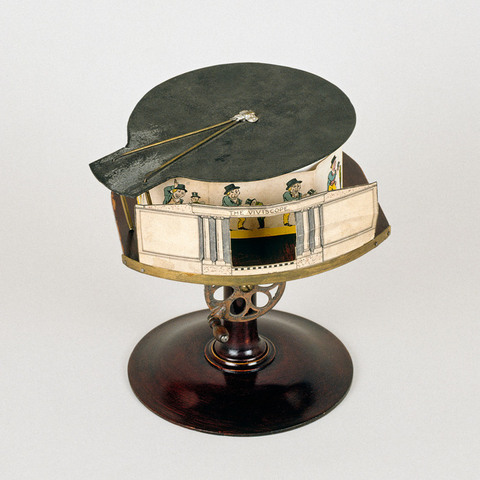Zootrope (variante du)
Fiche détaillée
Type de l'appareil
bande en papier ; lithographie en couleurs ; douze images d'un mouvement
Auteurs
Farnum William Carlton
Arlington, Comté de Bennington, Vermont
Fabricants
Hazelbank
Sydenham Hill, S.E.
Elias Bernard Koopman
New York, 50 Union Square, N. Y.
Utilisateurs
Farnum William Carlton
Arlington, Comté de Bennington, Vermont
Distributeurs
Informations non disponibles
Sujet du modèle
Homme de grande taille parlant à un autre homme plus petit
Objectif
Informations non disponibles
Taille de l'objet
Ouvert :
Informations non disponibles
Fermé :
Longueur : 58 cm
Largeur : 5.7 cm
Diamètre :
Informations non disponibles
Taille de la boîte de transport
Informations non disponibles
Remarques
"The Viviscope. By the name "wheel of life", the younger generation will probably locate a well-known scientific toy. The Viviscope is a new and improved form for bringing about the effect of moving figures, and forms a useful present for a child, and will afford excellent amusement at juveline parties. Bands of coloured pictures are placed in position, with the pictures facing a species of proscenium, and the handle is turned. Life-like motion is given to the subject, as seen either through the opening or at the sides. This scientific toy, which is dealt in by M. G. Fowler, 70 Great Saffron Hill, London E.C., is having the large sale which it certainly deserves. It is inexpensive, and supplies no end of amusement" (The Optical Magic Lantern Journal and Photographic Enlarger, février 1897, p. 38).
"Si une bande sans fin de longueur déterminée est enroulée autour d'un cylindre dont la circonférence est moindre que la longueur de la bande, l'excès de longueur de la bande par rapport à la circonférence du cylindre forme une section lâche qui, si la bande est passée d'un côté sur le cylindre, forme une boucle ou ondulation. Or si cette ondulation de la bande est amenée à circuler autour du cylindre sans que la bande file ou glisse sur ce dernier, l'effet produit par le contact de la bande et du cylindre sera de telle sorte qu'un point quelconque de la bande, au moment où il est embrassé par l'ondulation, sera soulevé du cylindre élevé au point culminant de l'ondulation, et après l'avoir passé, sera abaissé sur le cylindre à un point distant de celui qu'il occupait primitivement de la différence entre la longueur de la bande et la circonférence du cylindre" (W.C. Farnum, brevet d'invention n° 250 987, 15 octobre 1895 : "Perfectionnements aux kinétoscopes pour annonces et exhibitions").
"The Viviscope consisted of a hand driven geared mechanism working on a vertical spindle mounted in a hollow column, attached to the base. Fixed to the top of the column was a platform, having a shallow tin cylinder. An arm carrying a roller fixed to its longest end, was attached to the verticle spindle, which imparted the necessary movement to the paper figure bands, and passed each successive picture in the form of a loop, in front of the viewing aperture. The strips of pictures were somewhat similar to those used in the zootrope, with the exception that the two ends were joined together to form an endless band, and by placing one of these bands of pictures in correct position on the instrument, and turning the handle the figures were shipped in rapid sequence from one phase of movement to the next, and when viewed through the framed opening, apparent movement could be observed. It is interesting to read the patent specification of the Viviscope, as the inventor claims for the application of its use as being eminently suitable for advertising purposes in railway trains and for exhibition purposes. There were also suggested different forms, amongst which was a rather elaborate multiple instrument, but it achieved no commercial success" (Will Day, tapuscrit 25 000 Years to Trap a Shadow, archives Cinémathèque française).
"The Viviscope was the brainchild of a Mr William C. Farnham of Arlington in Remmington Country, Vermont, USA. It was patented by him on 16 October 1895, US patent n° 547 725, and produced in America by E. B. Koopman, 50 Union Square, New York, who claimed to be the sole manufacturer. [...] Nothing is known at present about its inventor William Farnham but his champion Elias Bernard Koopman (1860-1929) is well known to film history being one of the four co-founders of the American Mutoscope and Biograph Co. The three others were Dickson, Casler and Marvin" (Bill Barnes, "The Viviscope", The Magic Lantern, Londres, Magic Lantern Society, 2018, p. 10-11).

